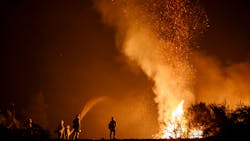Weary Crews Readying for Peak of Wildfire Season
By Kevin Fixler
Source The Press Democrat, Santa Rosa, Calif.
The noon sun beat down above the Mendocino National Forest as the U.S. Army’s Lancer Brigade out of Fort Lewis, Washington, scaled a 45-degree hillside on the Ranch fire’s northeasternmost flank.
Donning yellow firefighter gear, the units groaned as they made their way up in a single file. They were on a tedious mission, uprooting plants and shrubs to cover an area a bulldozer ripped up earlier this summer to cut a fire line.
Few had experience battling fires or had spent much time in California. But a month into their emergency deployment to assist with the state’s largest wildfire in recorded history, their suppression work continued Thursday.
Veteran Ventura County firefighter Rob Molina, acting as a crew boss, barked out orders when the group reached the top. In a leave-no-trace approach, they used their axes to spread out the vegetation on the barren ridge the bulldozer cut up to allow for proper flow once the rain comes.
“This is our area, so do it good,” said Molina, gesturing to a space between two power poles before tucking a pinch of mint Copenhagen chewing tobacco under his lip. “Make this our area.”
Nearly 1,000 fire personnel, including the enlisted ranks from Washington state and inmate volunteers from Nevada, remain on the massive, month-old Ranch fire as the large-scale operation closes in on full containment. Combined with the nearby River fire — known together as the Mendocino Complex — the blazes have burned 459,123 acres of wildland and destroyed 157 homes and 123 other structures in Lake and Mendocino counties.
Sunday night, the blazes were 97 percent contained, with full containment expected Sept. 9.
To bring the fires under control, it took a unified effort from Cal Fire, the U.S. Forest Service and thousands of firefighters from local agencies and throughout the nation. At its peak during the second week of August, nearly 4,100 fire personnel manning 380 engines, 100 water trucks, 90 bulldozers and 19 helicopters arrived to etch in containment lines and encircle the fires.
Resources initially were slow to arrive as firefighters battled the season’s deadliest blaze thus far, the Carr fire. It ignited July 23 in Shasta County and spread to neighboring Trinity County, killing seven people and razing 1,600 structures while consuming almost 230,000 acres.
The Mendocino Complex started just five days later.
“These firefighters never regrouped. They never went back to the station,” said Deputy Chief Scott McLean, a Cal Fire spokesman. “They went from one fire to the next to the next to the next. Usually after a major incident, you get to demobilize and get back to the stations, retool and rest and do what you need to do. This year, it’s been one fire after the other.”
The Mendocino Complex is the nation’s largest fire this year, McLean said. It comes on the heels of last year’s unprecedented fire season that saw 1.4 million acres burn across California.
So far this year, fires have burned 1.2 million acres in California, requiring a record 14,000 out-of-state firefighters to assist with mutual aid, according to Cal Fire.
Also, six firefighters died responding to the wildfires between July 13 and Aug. 13.
With two months still to go in what has become the height of the state’s fire season, the personal toll on local fire crews grows as well, as they push through the longer, hotter and more intense seasons.
———
©2018 The Press Democrat (Santa Rosa, Calif.)
Visit The Press Democrat (Santa Rosa, Calif.) at www.pressdemocrat.com
Distributed by Tribune Content Agency, LLC.






